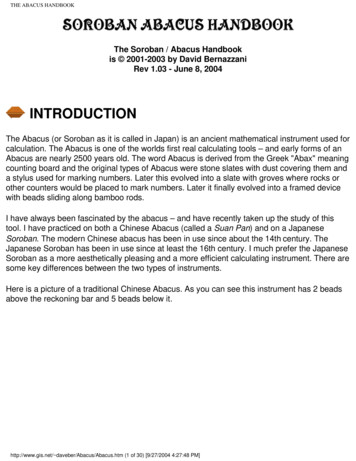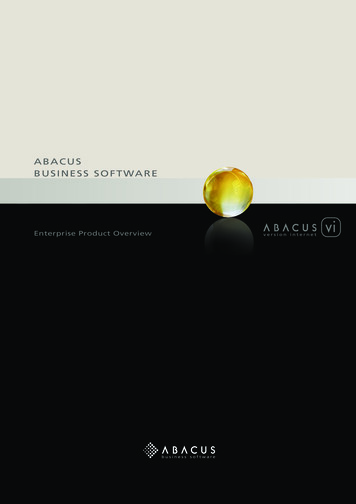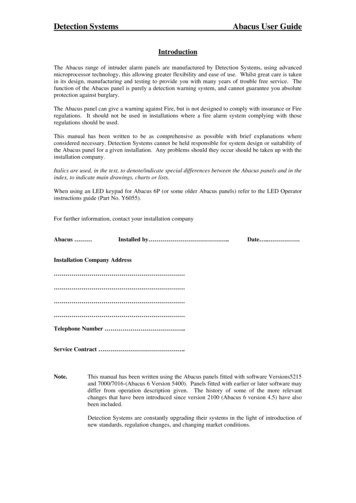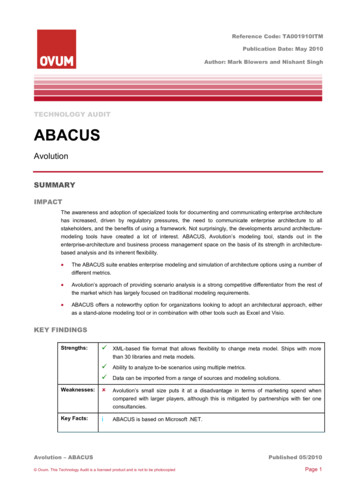
Transcription
THE ABACUS HANDBOOKThe Soroban / Abacus Handbookis 2001-2003 by David BernazzaniRev 1.03 - June 8, 2004INTRODUCTIONThe Abacus (or Soroban as it is called in Japan) is an ancient mathematical instrument used forcalculation. The Abacus is one of the worlds first real calculating tools – and early forms of anAbacus are nearly 2500 years old. The word Abacus is derived from the Greek "Abax" meaningcounting board and the original types of Abacus were stone slates with dust covering them anda stylus used for marking numbers. Later this evolved into a slate with groves where rocks orother counters would be placed to mark numbers. Later it finally evolved into a framed devicewith beads sliding along bamboo rods.I have always been fascinated by the abacus – and have recently taken up the study of thistool. I have practiced on both a Chinese Abacus (called a Suan Pan) and on a JapaneseSoroban. The modern Chinese abacus has been in use since about the 14th century. TheJapanese Soroban has been in use since at least the 16th century. I much prefer the JapaneseSoroban as a more aesthetically pleasing and a more efficient calculating instrument. There aresome key differences between the two types of instruments.Here is a picture of a traditional Chinese Abacus. As you can see this instrument has 2 beadsabove the reckoning bar and 5 beads below it.http://www.gis.net/ daveber/Abacus/Abacus.htm (1 of 30) [9/27/2004 4:27:48 PM]
THE ABACUS HANDBOOKAnd here is a picture of a traditional Japanese Soroban. Here we have a streamlinedinstrument with 1 bead above the reckoning bar and 4 below it.Originally the Japanese Soroban looked much like the Chinese Abacus (5 beads below, 2beads above) but it was simplified around 1850 and reduced to a single bead above thereckoning bar and later in 1930 to just 4 beads below it.It doesn't matter which type you use – both have the same procedure for recording numbersand performing addition, subtraction, multiplication and division. The Chinese abacus iscapable of counting 16 different numbers from 0 to 15 on each individual rod which was usefulsince their units of weight were (are?) measured in 16ths. For westerners – this is not veryuseful unless you want to do calculations in 16ths of an inch or maybe hexadecimal (forcomputer programs which is base 16). Of course you don't have to use all the beads – so youcan always just represent numbers 0-9 which is most useful for our purposes. The JapaneseSoroban has been streamlined for the Hindu-Arabic number system and each rod canrepresent one of 10 different numbers (0-9) and has no wasted beads for our decimalcalculations. Read on to discover how numbers are represented on the abacus frame.I have researched both types and studied different methods for performing operations on thehttp://www.gis.net/ daveber/Abacus/Abacus.htm (2 of 30) [9/27/2004 4:27:48 PM]
THE ABACUS HANDBOOKboard. I will try to instruct and teach only the best methods that I have found. Generally, theseare the methods described by Takashi Kojima in his excellent book "The Japanese Abacus –It's Use and Theory" published first in the 1950's and later reprinted. I assume the reader wantsto know the best prescribed procedures for learning how to use the abacus. I will try to take noshortcuts – and hope that this handbook serves as a fine introduction to the marvelous world ofthe Abacus. One might ask why anyone should bother learning how to use the Abacus with theadvent of such cheap calculators. The answers will be different for everyone – but for me it wasa desire to learn and understand this ancient skill and to become skilled myself with thisfascinating tool. I also find the practice on the Soroban very relaxing – often helping me unwindafter a day at work. I suppose it is as much a hobby as anything else. With practice and thehelp of this handbook, you can master the Abacus! If you don't have an instrument, you canfind proven suggestions at the end of this handbook for tracking one down or making oneyourself!USING THE ABACUSThe beads on the abacus slide up and down on what we call rods which are dividedhorizontally by a reckoning bar (some call this the beam). In general, the single row of beadsabove the reckoning bar (called "Heaven Beads") are worth 5. The beads below the reckoningbar (called "Earth Beads") are worth 1. A bead is said to "have value" when it is pushedtowards the middle reckoning bar and "loses value" when moved away from the middlereckoning bar. Forming a number on the abacus is very simple – simply move a bead towardsthe reckoning bar for it to "have value". Let's look at this virtual abacus frame and "read" thenumber.Since no beads are touching the middle reckoning bar, we read a number of 0 all the wayacross the abacus. This is a "cleared" frame and it is how you normally start every mathproblem (similar to a reset on a modern calculator). To clear a Soroban – you simply tilt ithttp://www.gis.net/ daveber/Abacus/Abacus.htm (3 of 30) [9/27/2004 4:27:48 PM]
THE ABACUS HANDBOOKtowards you so that all the beads are pulled by gravity towards the bottom of the frame (thisclears the lower beads only!) and then level the instrument again and make a sweeping motionof your index finger between the reckoning bar and the upper row of beads – this will causethem to "push" upwards away from the reckoning bar. It's almost as if you were splitting thebeads from the reckoning bar with a parting sweep of your finger. You could just move them upindividually with a flick of your index finger – but the sweeping method from left to right is veryfast and efficient once you get the hang of it.Notice the little dots on the reckoning bar. We use these dots on every third column todesignate a "unit" rod. You should place your number so that the unit portion falls on this rod(for example ,in the number 1234 the value 4 is the "units", 3 is the "tens", 2 is the "hundreds",etc). Use rods to the right of this unit rod as tenths, hundredths, and rods to the left as tens,hundreds, thousands (which also has a unit dot – very convenient!). It doesn't matter which dotyou choose to be the unit rod – so long as it is marked with a dot for easy reference. Numberscan be formed on the abacus anywhere you want – and with some problems (like multiplicationand division) there will be two or three sets of numbers on the abacus frame. Do not think of thedot as a decimal point – that might get confusing as to whether that rod is representing thevalue just before the decimal point or just after it. It is a unit rod – and rods to the right have afactor of 10 less value and rods to the left have a factor of 10 more. For example, lets assumein the diagram above we chose E as our unit rod. We would then have:RodWhat it RepresentsRod ATen Thousands (10000's)Rod BThousands (1000's)Rod CHundreds (100's)Rod DTens (10's)Rod EUnits (1's)Rod FTenths (0.1's)Rod GHundredths (0.01's)Rod HThousandths (0.001's)http://www.gis.net/ daveber/Abacus/Abacus.htm (4 of 30) [9/27/2004 4:27:48 PM]
THE ABACUS HANDBOOKRod ITen Thousandths (0.0001's)Before we move on, you have just enough information to understand the way numbers areformed on the frame. I will take the time here to give you some tips for Soroban mastery –some of these won't make sense until later in the handbook – but you can start to apply themas you learn the full techniques for the different operations we will perform on the Abacus. Always work numbers on the Abacus from left to right. It's the most efficient way. Don'tfall into old habits of trying to add and subtract starting at the right (as you would withpencil and paper).When using the Abacus, place it on a level surface – steadying it with your left hand ifnecessary and work with your right hand (otherwise you partially block and covernumbers needlessly as you work with it).Use two fingers for bead manipulation only – the thumb is always used when moving oneor more earth beads up to the reckoning bar. The index finger is used for everything else(moving earth beads back away from the reckoning bar and moving heaven beads toand from the reckoning bar). Use just enough force to move the beads – do not slamthem which can disrupt beads on neighboring rods.When performing addition, always finish moving beads on the current rod before dealingwith any carry to the tens rod (which is always the rod to the left of the one you areworking on – it will always have 10x the value of the current rod).When performing subtraction, always borrow from the tens rod before finishing movingbeads on the current rod (which is always the rod to the left of the one you are workingon – it will always have 10x the value of the current rod).ADDITIONLet's put a real number on the Abacus. Let's put the number 21 on the frame. We convenientlychoose rod H as our unit rod and form the number.http://www.gis.net/ daveber/Abacus/Abacus.htm (5 of 30) [9/27/2004 4:27:48 PM]
THE ABACUS HANDBOOKHere we have placed the value of 2 on rod G (by moving 2 earth beads worth 1 each towardsthe reckoning bar) and the value of 1 on rod H (by moving a single earth bead worth 1 eachtowards the reckoning bar). I will henceforth use shorthand for this and simply say "Place 21"which means to place 21 on the frame (remember to observe the unit rod when you place thenumbers – it will help you to remember the size and position of the number more easily as thecalculations get more complicated).It's important to know that when you enter this number on the frame, you should enter it fromleft to right. Numbers are read and spoken from left to right and so it's much more efficient toenter them on the frame in the same manner. Again, be sure your number ends up on a unitrod for convenience.Now let's add 6 to this number.As you can see, we added 6 to the units place of the original number (21) on the frame. We dothis by moving 6 worth of beads towards the reckoning bar for rod H. We don't have enoughearth beads (worth 1) to do it so we must take a single heaven bead (worth 5) and a singleearth bead (worth 1) to make the 6 we need. Using the proper fingering techniques describedbefore – you use your thumb to move up the singe earth bead and your index finger to movedown the single heaven bead. This can be done in one motion – almost a "squeezing" effecthttp://www.gis.net/ daveber/Abacus/Abacus.htm (6 of 30) [9/27/2004 4:27:48 PM]
THE ABACUS HANDBOOKthat is very efficient. After moving those beads towards the reckoning bar (henceforth in thisdocument called "Add 6") you can now "read" the value resulting on the frame. Rod G has avalue of 2 and rod H (our unit rod) has a value of 7. The answer, therefore, is 27. There, you'vejust added your first numbers on the Soroban!Now, let's get tricky! We will take this resulting answer (27) and add 15 to it. Starting with the 1in "15" we want to put this on Rod G – so we simply "Add 1" by moving a single bead towardsthe reckoning bar. See the following resulting frame which now contains the value of 37 (not thefinal answer, just the intermediate value after adding the 1 in "15").And now we must add the 5 of the "15" (remember, we are working from left to right with thesenumbers) and so we must "Add 5" on the unit rod (H). Wait! We don't have 5 beads to workwith – so instead we "Subtract 5" and "Add 10" which involves a shift to the next column up (tothe left which is 10 times the value of the current rod). This is a key concept on the Abacus –we didn't have enough to "Add 5" to our unit column so we must instead "Subtract 5" on the unitrod and then "Add 10" (by moving a single earth bead worth 1 in the next column up – in thiscase rod G). In this case, always work with the current rod first – moving a single heaven beadaway from the reckoning bar on H and then moving up a single earth bead on G.This results in the following frame:http://www.gis.net/ daveber/Abacus/Abacus.htm (7 of 30) [9/27/2004 4:27:48 PM]
THE ABACUS HANDBOOKAs you can see, the resulting number on GH is 42 which is the result of adding 15 to 27. It isimperative to remember that when wanted to add the 5 to the unit rod H, you did not mentallysay "Well there is 7 already on the rod, and I'm adding 5 so that is 12 – I must somehow form12 on the frame!". That line of thinking will make abacus processing very slow – the right way todo it is to know that you must "Add 5" on H – if you lack the beads, you must "Add 1" on thenext highest rod and "Subtract 5" on the unit rod which accomplishes the same thing. This sortof mechanical processing is quick to learn and allows for incredible efficiency when workingwith the Soroban.The same borrowing processing results even within a single rod. Let's look at the followingnumber 14 on the frame:Now we want to add 1 to this. To do so would be simple enough if we had a single availableearth bead on Rod H. But all of the earth beads already "have value" because they are pushedtowards the reckoning bar. But we still have a heaven bead on rod H that does not "have value"because it is not pushed towards the reckoning bar. But it's value would 5 which is too large –so instead we "Add 5" (by moving the single heaven bead towards the reckoning bar) and"Subtract 4" to give us a net increase of just one. Now we have a frame that looks like:http://www.gis.net/ daveber/Abacus/Abacus.htm (8 of 30) [9/27/2004 4:27:48 PM]
THE ABACUS HANDBOOKAnd you can see the result is 15 (14 1).OK – now you are ready for something really meaty. Let's add some serious numbers – nomatter how many numbers you deal with, just work with one rod at a time and generallyproceed from left to right. Lets try 3345 6789 ( 10134).First, Place 3345 on the frame:Next (working from left to right) we want to "Add 6" of 6789 on rod E. This is simple enough –simply squeeze the one remaining earth bead and the heaven bead towards the reckoning barwhich results in a frame that looks like this:http://www.gis.net/ daveber/Abacus/Abacus.htm (9 of 30) [9/27/2004 4:27:48 PM]
THE ABACUS HANDBOOKThis is the number 9345 but we are not done – there are still three more numbers to go! Nextwe "Add 7" on rod F. Here we have to carry – a simple glance at the rod will show that there arenot 7 worth of beads to move to the reckoning bar. So instead, we "Subtract 3, Add 10" (whichis the same as adding 7). We do this by moving down 3 beads on Rod F ("Subtract 3") andthen moving up a bead on Rod E (technically "Add 1" but this rod has 10x's the value of rod Fso in effect it's like adding 10 to Rod F although the work is done with a single bead on the nextcolumn to the left – this is a key concept in the use of the Soroban!).We would be done with this number except that there are no free beads on Rod E – so againwe must carry to the next rod to the left and "Subtract 9, Add 10" which gives us the sameeffect. This leaves us with a single bead moved up on Rod D ("Add 1") and nothing on Rod E("Subtract 9" which is the total of all the beads previously at the reckoning bar on this rod). Thisresults in the following frame:This is the number 10045. But again, we are not done. Just two more numbers to go. As youcan see, the act of carry in addition to the next rod to the left is commonplace with addition –and with practice will become very easy – it can be done as quickly as someone can read offsets of numbers to you. I've found that with just a few weeks of practice, this process becomesvery natural. Next we "Add 8" on rod G. Again we don't have enough beads to add 8 so wehave to carry. In this case we "Subtract 2" and "Add 10". Therefore we move down two earthhttp://www.gis.net/ daveber/Abacus/Abacus.htm (10 of 30) [9/27/2004 4:27:48 PM]
THE ABACUS HANDBOOKbeads from rod G and add a single bead to Rod F (which is effectively adding 10 to Rod Gbecause it is one rod to the left). The resulting frame looks like:This is the number 10125. We are almost done! Just a final digit to add – the "9". So we "Add 9"to the unit rod H. Again, we don't have enough beads to do this with rod H so we must"Subtract 1" and "Add 10". To subtract 1, where we already have a value of 5, we must moveaway the heaven bead and move the four earth beads to the reckoning bar (essentially"Subtract 5", "Add 4" on this rod). Only after we deal with the unit rod H should we "Add 10"which is accomplished by going to Rod G and adding a single earth bead. When performingaddition, always deal with the current rod first – and then if there is a carry move up a singlebead on the rod to the left. These are very essential concepts when adding! After performingthis step, we have the following resulting frame:It's easy enough to read this frame and see that the resulting number is 10134 – which is theanswer to our original problem (3345 6789)! A problem like this may seem strange or evenawkward at first – but with a bit of practice, you should be able to work a problem like this in justa few seconds. Even faster and more accurately than you might be able to do it on paper!http://www.gis.net/ daveber/Abacus/Abacus.htm (11 of 30) [9/27/2004 4:27:48 PM]
THE ABACUS HANDBOOKSUBTRACTIONSubtraction on the Abacus is almost as simple as Addition was - it's just the reverse process.Instead of having to deal with a possible carry in the 10's digit (next rod to the left), you nowdeal with a possible borrow on that same rod. In general, with subtraction you still work theproblem and numbers from left to right - just deal with one rod at a time. If there are enoughbeads that "have value" on the current rod you can just subtract the desired number. If youdon't have enough beads with value - you must first subtract 10 (by losing one beads worth ofvalue on the rod to the left of the one you are working on) and then add on your current rod tomake up the difference. We will give some concrete examples to show how easy this is.Let us take the number 47 (Place 47):And let's subtract off 21. First we start on Rod G and "Subtract 2" which is easily accomplishedby moving 2 earth beads away from the reckoning bar. We now have the value 27 (not the finalanswer yet):http://www.gis.net/ daveber/Abacus/Abacus.htm (12 of 30) [9/27/2004 4:27:48 PM]
THE ABACUS HANDBOOKNow we move on to the units rod H and "Subtract 1" by moving a single earth bead away fromthe reckoning bar. This yields us our final answer of 26:Now let's subtract 4 from this. We can go right to the units rod and "Subtract 4" except thatthere are not enough single earth beads (worth 1 each) to subtract 4 so instead we must"Subtract 5, Add 1" to give us the same effect. Here we move a single heaven bead (worth 5)away from the reckoning bar and move a single earth bead (worth 1) up to the reckoning bar toaccomplish this. We now have our final answer of 22 (which is the result of 26-4):Now we show how to borrow. Let's take the 22 on the frame and subtract off 14. First we startwith rod G and "Subtract 1" which is easy. Our result (not yet the final answer) is:http://www.gis.net/ daveber/Abacus/Abacus.htm (13 of 30) [9/27/2004 4:27:48 PM]
THE ABACUS HANDBOOKNow we must "Subtract 4" from our unit rod H. But we don't have 4 worth of beads to subtracton this rod - so instead we must "Subtract 10, Add 6" to produce the same result. Toaccomplish this, we subtract a single earth bead from rod G (effectively "Subtract 10" since rodG has 10 times the value with respect to rod H which we are working with) and then we "Add 6"to rod H (here we need to move both a Heaven bead and an Earth bead towards the reckoningto accomplish the "Add 6"). This results in a frame with 8 which is our answer!MULTIPLICATIONMultiplication is nothing more than a series of additions. However, it is not very convenient todo 23 separate adds on the number 47 just to give us the answer to 23x47 ! Therefore, thereare specific techniques for performing multiplication on the abacus frame. I've learned twodifferent methods and know there are probably others as well – but I will teach only the methodthat was approved by the Japan Abacus Committee. I have found that this method is leastprone to errors and is very simple once you learn the basic technique. You will need to knowhttp://www.gis.net/ daveber/Abacus/Abacus.htm (14 of 30) [9/27/2004 4:27:48 PM]
THE ABACUS HANDBOOKyour multiplication table up to 9x9 81 and you should be all set.Let's say you are given a problem like 23x47. The number 23 is called the multiplicand and thenumber 47 is called the multiplier. In general you place the multiplicand (here 23) near thecenter of the frame – and keep the last digit on a unit rod (marked with a dot) to help keep yourplace (especially important in multiplication). Then enter the multiplier (here 47) to the left ofthis number – skipping two clear rods going to the left (do not worry if this number falls properlyon a unit dot – it's not necessary). Now you have both numbers on the frame. In the method Iwill describe you will be producing the answer just to the immediate right of the multiplicand(the number in the middle of your abacus frame). When we are done – the multiplicand will begone and the answer will remain (along with the multiplier still to the left).Lets place the 23 and 47 on the frame as we described above (except that I am only going toskip one blank column rod to conserve space in the diagrams! Some prefer skipping just onecolumn and you might have to do it if you have a small abacus – but generally it is better to skiptwo full columns):Now we are ready to multiply. It's similar to how you would work it on paper – except that theorder of multiplication is a bit different (and should be followed exactly as I outline here).First you work mostly with the multiplier. You take the right-most digit of the multiplier (in thiscase a '3') and you multiply it by the left-most digit of the multiplicand (in this case a '4'). Theresult is 12 – and so you add on the frame in the two rods to the right of the multiplicand (in thiscase FG). Since rods FG have no value, it's just a simple matter of "Add 1" to F and "Add 2" toG to produce the following frame:http://www.gis.net/ daveber/Abacus/Abacus.htm (15 of 30) [9/27/2004 4:27:48 PM]
THE ABACUS HANDBOOKNow we multiply the same multiplier digit '3' against the next multiplicand digit '7' and put thatresult on GH (since we last left off at G with the last multiplication result). 3x7 is 21 and so we"Add 21" to rods GH which means we "Add 2" to G and "Add 1" to H. Simple enough and hereis the resulting frame:Now we are done with the first digit of the multiplier and so we must clear it from the frame – wesimple clear the '3' off rod F. We will use this rod if there are more numbers in the multiplier left(and in this case there is another number left!).Now we move on to the next digit of the multiplier – in this case the '2'. We multiply this timesthe left-most digit of the multiplicand (just as we did above for the first digit of the multiplier).And again we place the result (2x4 08) on the two rods next to this multiplier digit – rods EF.Important note – the result of 2x4 is a single digit 8 – but enter this as 08 so that you alwaysuse up 2 rods so you are technically doing: "Add 0" on E followed by "Add 8" on F. Theresulting frame looks like:http://www.gis.net/ daveber/Abacus/Abacus.htm (16 of 30) [9/27/2004 4:27:48 PM]
THE ABACUS HANDBOOKWe are almost done – we just need to multiply the '2' times the remaining multiplicand digit of'7' and add the result of 14 to rods FG (remember we pick up where we left off so long as wehaven't moved on to a new multiplier digit). In this case we "Add 1" to F which requires a carryto E (which you should already know how to do from the addition examples). And then you"Add 4" to G. You clear off the multiplier digit '2' which has now been processed and see thatthere are no more multiplier digits left (if there were, you just repeat the above processing). Theresulting frame (after clearing away the '2' and you can also clear away the original '47' on theleft hand side if you like – but we don't bother do it here) yields the resulting frame:And so you can read the result of 23x47 1081 although we still left the 47 on the left side of theframe (you can clear it – I tend to just leave it there). No matter how many digits you multiply,just apply the technique above and remember to work on the correct rod and it will go smoothly.DIVISION (contributed by Totton Heffelfinger)http://www.gis.net/ daveber/Abacus/Abacus.htm (17 of 30) [9/27/2004 4:27:48 PM]
THE ABACUS HANDBOOKFor me at least, division was a little intimidating. As it turns out Dave was right when he said, "Trust me.It's not that hard!" As with multiplication you will need to know your multiplication tables up to 9 x 9 81. It might be helpful to think of division as being nothing more than a series of subtractionsThe techniques I use below are pretty much as they are described in "The Japanese Abacus - It's Use andTheory" by Takashi Kojima.In describing the methods I will use standard terminology. For example in the problem 8 2 4, 8 isthe dividend, 2 is the divisor, and 4 is the quotient.Earlier in the handbook Dave wrote about the importance of the Unit rod. (Unit rods are those rodsmarked with a dot.) Unit rods seem particularly important in solving problems of division because theresulting quotient is often not a perfect whole number. In other words it forms a decimal. Because of thisyou should plan ahead and set up the problem on your abacus so that the unit number in the quotient fallson a unit rod. Also, in order to help you keep track of your calculations it is a good idea to set the unitnumber of your dividend on to a unit rod. As for the divisor, if it's a whole number it doesn't seem tomatter much whether it follows any such rule.Normally when setting up division problems on the abacus the dividend is set a little to the right of centerand the divisor is set to the left. Traditionally the dividend and divisor are separated by three or fourunused rods and this is where the quotient will be formed. Having said that, occasionally I find that fourunused rods are not enough and I use more. It really depends on the problem.Basically division is done by dividing a single digit into one or possibly two digits at a time. You'rerequired to multiply after each division step and do subtraction to get the remainder. The remainder isthen tacked on to the rest of the dividend and the division is continued in this way until its completed. It'snot unlike doing it with pencil and paper but the abacus has the advantage of doing much of the gruntwork for you.As you will see I'll set up a few examples with both a whole number and a decimal in the quotient. All isbetter explained using examples. So let's get started.Example 1. 837 3 ?Step 1: Place the dividend 837on the right-hand side of the abacus (in this case on rods G, H & I) and thedivisor 3 on the left (in this case rod B). Notice how the "7" in 837 falls on a unit rod.http://www.gis.net/ daveber/Abacus/Abacus.htm (18 of 30) [9/27/2004 4:27:48 PM]
THE ABACUS HANDBOOKThis yields the resulting frame:Step 1A B C D E F G H I J K L M.0 3 0 0 0 0 8 3 7 0 0 0 0Step 2: It looks like the quotient is going to have 3 whole numbers in its answer. Begin by placing thefirst number of the quotient on rod D, that way the unit number in the quotient will fall on unit rod F. Inorder to divide 837 by 3, start with the 8 in the dividend. It looks like 3 goes into 8 twice with aremainder. Place 2 on rod D. Multiply 2 x 3 to equal 6, then subtract 6 from 8 leaving a remainder of2.This yields the resulting frame:Step 2A B C D E F G H I J K.0 3 0 0 0 0 8 3 7 0 02- 60 3 0 2 0 0 2 3 7 0 0L M.0 00 0Step 3: Now there's 237 left with on rods G, H & I. Continue by dividing 23 by 3. It looks like 3 willgo into 23 seven times with a remainder. Place 7 on rod E. Multiply 7 x 3 to equal 21, then subtract 21from 23 leaving a remainder of 2.http://www.gis.net/ daveber/Abacus/Abacus.htm (19 of 30) [9/27/2004 4:27:48 PM]
THE ABACUS HANDBOOKThis yields the resulting frame:Step 3A B C D E F G.0 3 0 2 0 0 27- 20 3 0 2 7 0 0H I J K L M.3 7 0 0 0 012 7 0 0 0 0Step 4 and Result: Now there's 27 left on rods H & I. Continue by dividing 3 into 27. 3 goes into 27nine times perfectly. Place 9 on rod F. Multiply 9 x 3 which equals 27, then subtract 27 from 27leaving 0. Notice how the "9" in 279 falls on unit rod F.We're done. 279 is the correct answerStep 4A B C D E F G.0 3 0 2 7 0 090 3 0 2 7 9 0H I J K L M.2 7 0 0 0 02 70 0 0 0 0 0Example 2. 6308 83 ?Step 1: Place the dividend 6308 on the right-hand side of the abacus (in this case on rods F, G, H & I)and the divisor 83 on the left (in this case rods A & B). Notice how the "8" in 6308 is placed on a unitrod.http://www.gis.net/ daveber/Abacus/Abacus.htm (20 of 30) [9/27/2004 4:27:48 PM]
THE ABACUS HANDBOOKThis yields the resulting frame:Step 1A B C D E F G H I J K L M.8 3 0 0 0 6 3 0 8 0 0 0 0Step 2: In looking at the problem it's evident that 83 will not go into 6 nor will it go into 63. But it willgo into 630. It looks like the quotient will have two whole numbers and a possible decimal. Thereforebegin to form the quotient on rod E so that the unit number in the quotient will fall on unit rod F.2a: In order to divide 6308 by 83, start with the 8 in thedivisor and the 63 in the dividend. It looks like 8 goes into 63seven times with a remainder. Place 7 on rod E. Multiply 7 x 8which equals 56, and subtract 56 from 63 leaving a remainderof 7.2b: Now there's 708 left on rods G, H & I. Because we'vemultiplied the "8" in 83 by 7, we must multiply the "3" in 83by 7. 7 x 3 equals 21. Subtract 21 from 70 leaving aremainder of 49.Step 2aA B C D E F G H I J K.8 3 0 0 0 6 3 0 8 0 07- 5 68 3 0 0 7 0 7 0 8 0 0L M.0 00 0The resulting frame after steps 2a & 2b:Step 2bA B C D E F G.8 3 0 0 0 0 77- 28 3 0 0 7 0 4http://www.gis.net/ daveber/Abacus/Abacus.htm (21 of 30) [9/
The Abacus is one of the worlds first real calculating tools – and early forms of an . are the methods described by Takashi Kojima in his excellent book "The Japanese Abacus – . earth beads (worth 1) to do it so we must take a single heaven bead (worth 5) and a single earth b










